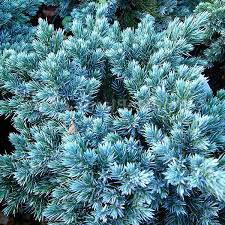Juniperus vulgaris
Juniperum vulgaris - smalla shrubby plant belonging to the family of cypress (Cupressaceae). This upright bush can grow up to three meters high. The adult plant has a bark of dark gray color, which is separated from the trunk by scales. On young trees it is shiny, light-brown or reddish. Leaflets up to 16 mm long, narrowly linearly lanceolate, are located whorls of three pieces. To the touch they are prickly and hard. The plant does not discard the leaves for the winter.
Juniper ordinary refers to dioeciousshrubs, i. on one plant only male flowers, and on the other female. Male flowers are in the sinuses, in the form of oblong earrings, and women form small bumps. The cones have about 10 rows of scales, the upper ones of which are fruiting. After fertilization, the cones increase in size, transforming into a fruit - a berry-shaped cone. Fruit ripening occurs in the second year. By the time of their maturation, they change color from light green to black, acquiring an oval shape. Their length is about one centimeter.
Common Juniper prefers sandyor stony soil, coniferous (pine) or deciduous-coniferous forests. On an even sandy soil, it grows upright straight, and on gravelly soil, the slopes of mountains, grows in the form of a shrub bush.
For herbal medicine, as a medicinal raw material,collect ripe fruits (cones). Maturation in many regions of Russia occurs in September-October. Collecting fruits with their hands is difficult, since the plant is barbed, so under the tree lay a cloth and shake off the ripe berries.
Drying the fruit is carried out in special dryers with a constant temperature or heated rooms, periodically shoveling the fruit.
Where do junipers grow? Varieties of plants
Common juniper in the wild can bemeet in the mountains of the Caucasus, the Urals, the Altai Territory. It is widely used as an ornamental plant on private plots, parks, in the design of alpine hills. In addition to ordinary juniper, juniper Cossack, juniper Siberian, Chinese, Virginia are also known. In Russia, in connection with the severe winter climate, the common juniper Hibernica is widely popular, known for its frost resistance, unpretentiousness and beautiful cone-shaped crown.
The fruits of the plant are rich in sugar (about 40%), they contain essential oils, waxes, organic acids, juniperin (coloring matter). The leaves contain a lot of vitamin C and phytoncids.
Application of juniper in medicine
The fruits of the plant have a strong diuretic effect. But with kidney diseases, it is rarely used, as it has a strong irritant effect on them.
Juniper has a choleretic and disinfectant effect (due to phytoncids).
Ointments, baths and decoctions of it treat rheumatism and joint diseases. Decoction is prepared from branches. You can also use alcoholic infusion and essential oil diluted in cream.
Fruits stimulate appetite, possess a carminative effect, strengthen the separation of bile.
In otorhinolaryngology, an otitis treated with alcohol is treated with juniper. For this purpose, a tampon with this preparation is placed in the diseased ear.
Shrub for a day highlights a lot of phytoncides. They clean the air of harmful bacteria, well affect the respiratory system. The smell of juniper has a calming effect on the nervous system. Therefore, it is planted in large quantities in parks, sanatoria, rest homes, near medical institutions. In ancient times, they fumigated living quarters after a sick person stayed in them, brewed barrels for pickling. It was used for diseases of the skin, malaria, female diseases.
</ p>




